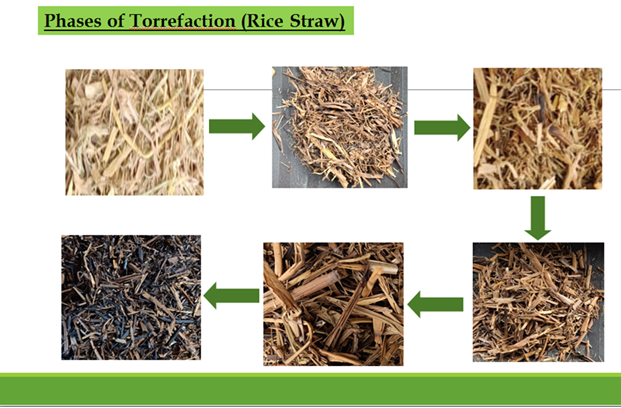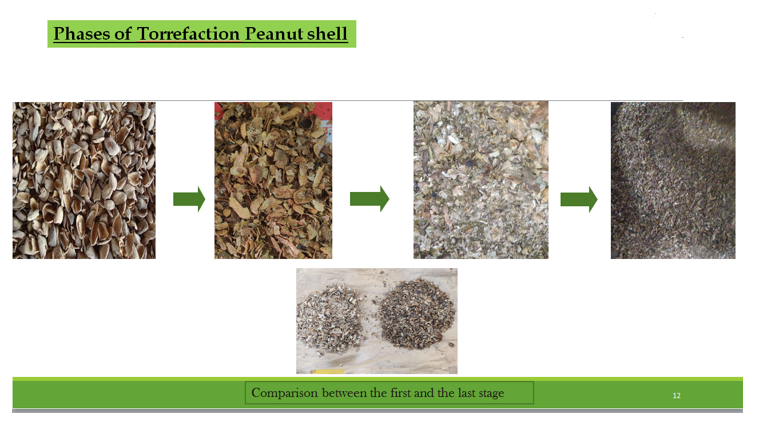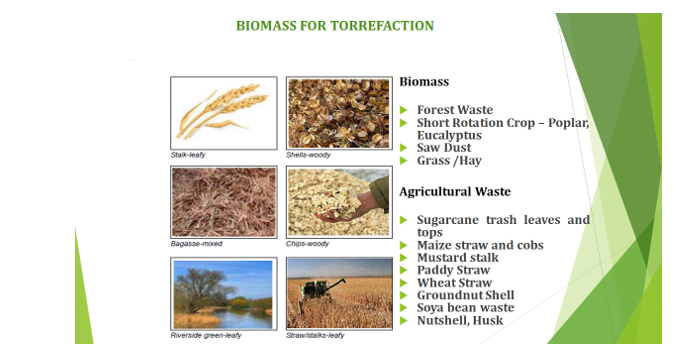TORREFACTION:India's First Rotary Torrefaction Unit to make Bio-Coal
Torrefaction is a thermal process
Torrefied biomass is the most elegant solution to convert raw biomass into a coal-like material.
Involves the heating of biomass with limited oxygen to a temperature of typically 200 to 300°C
Low cost of conversion in our in-house torrefied technology
Torrefaction enhances the fuel properties by adding higher energy density and near zero moisture whereby making the GCV and NCV nearly the same.
Resultant product has better fuel characteristics than the original biomass.
Simplified storage of the torrefied material.
Minimal biological degradation and water uptake
Makes biomass friable (80%-90% less energy consumption for grinding).
Transport and material handling is less expensive & easier
Significant loss of energy due to re-absorption of moisture in biomass (pellets) is saved
Low O/C ratio
Smoke producing compounds removed
Homogeneous output from mixed biomass
Easier Pelletisation
Torrefied pellets have more strength
Highly profitable conversion biomass into torrefied biomass; Economics are in favor
TORREFIED WOOD PELLETS COMPARED TO COAL
| CHARACTERSTIC | COAL | TORREFIED WOOD PELLETS |
|---|---|---|
| Heating Value | 18 GJ/T | >22 GJ/T |
| ASH | 20-30% | <3% |
| Sulphur | 3-5% | >0.01% |
| Nitrogen | 1.5-3% | <0.1% |
| Chlorine | 0.05% | >0.01% |
OUR TORREFYER MACHINE AT OUR YAMUNA NAGAR PLANT
We have developed India’s first torrefyer.
On the request of Ministry of Petroleum (Government of India) to look for the crop burning issue, we have found a solution for the major issue of Rice straw.
We have successfully converted Rice straw into Torrefied biomass (energy fuel).
Rice Straw torrefaction
Below are the test results and phases of torrefaction for Rice Straw


Torrefied groundnut shell
We have done multiple residues including Groundnut shell also (which is an economical option to convert biomass to biomass). Below are the test results and phases of torrefaction.


Different torreyers for different materials
We have developed multiple versions of torrefyer for different raw materials, multiple capacities and applications.
We have dealt with the toughest raw materials with our unique techniques, having 2 major solutions:
- Biomass to biomass.
- Pellets to torrefied pellets (We are specialist in pellets, so we have converted the pellets into torrefied pellets for higher energy.)
TORREFIED BIOMASS/PELLETS
- Compared to charcoal the retained volume of bio mass is more than 2 times and without the emissions associated with charcoal production and usage.
- VOCs & hemicellulose are combusted to generate process heat required to sustain the process.
- Warm lignin acts as a binder if TB is pelletized.
- Depending on the process time, the TB yield varies between 85% to 95%.
We provide integrated solutions from stage of raw material selection to equipment, to process know how, turnkey implementation and operational management as well as buy-back of torrefied pellets including made from rice straw.
Torgas
Post torrefaction, the properties of biomass undergo changes which are conducive and beneficial for better combustion, such key results are enumerated below:
- Part of the particle fiber structure is destroyed leading to improved grind ability.
- At lower torrefyer, temp relative content of cellulose increases Partial oxidative torrefaction.
- When biomass loses moisture, releases CO and CO 2 increasing atomic carbon.
- Decreasing H and O making biomass suitable for thermal conversion.
- Char reactivity or ash is reduced post torrefaction.
- Fixed carbon increases and VM reduces. All aid to complete - combustion process.
- Torrefaction process changes the properties of biomass.
List of certain raw materials
Since we are specialized in this, we are giving illustrative list of certain raw materials.

- Dried cashew nut shells
- Groundnut shells
- Maize stalk and cobs
- Wheat straw
- Rice straw
- Soya stalk and husk
- Cotton stalk
- Jute sticks
- Mustard stalk
- Almond shell
- Wood shavings
- Wood chips
Based on different geographical locations, the locally available agro residue can be readily converted into torrefied biomass / torrefied pellets.
